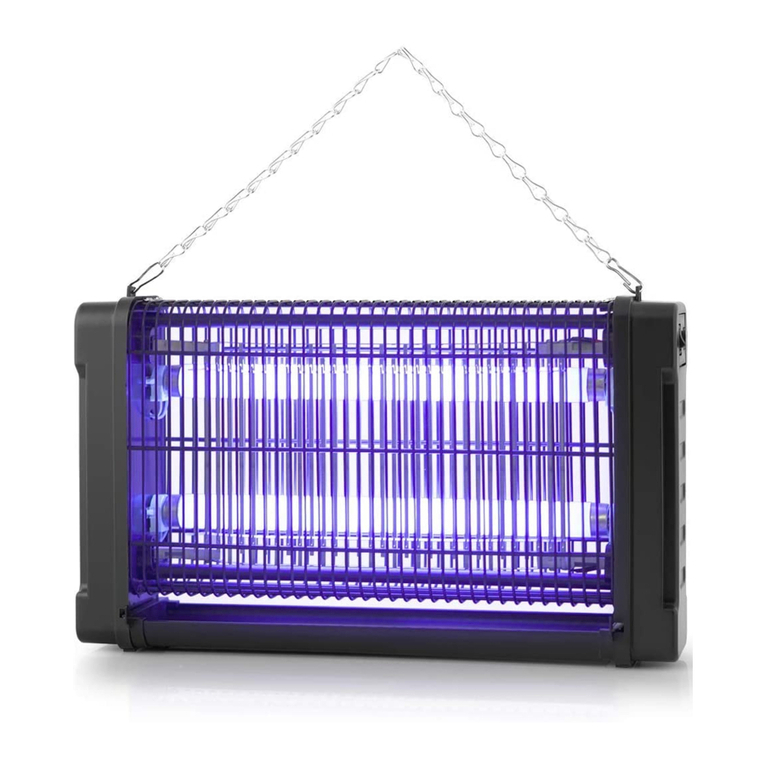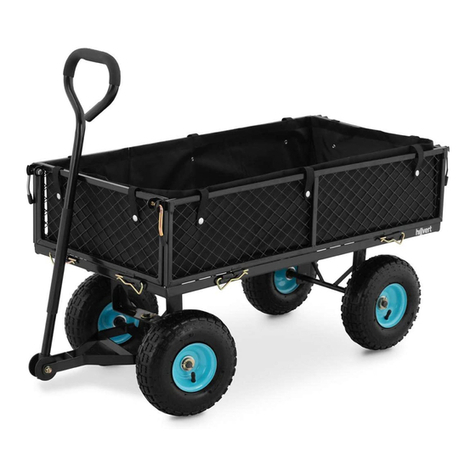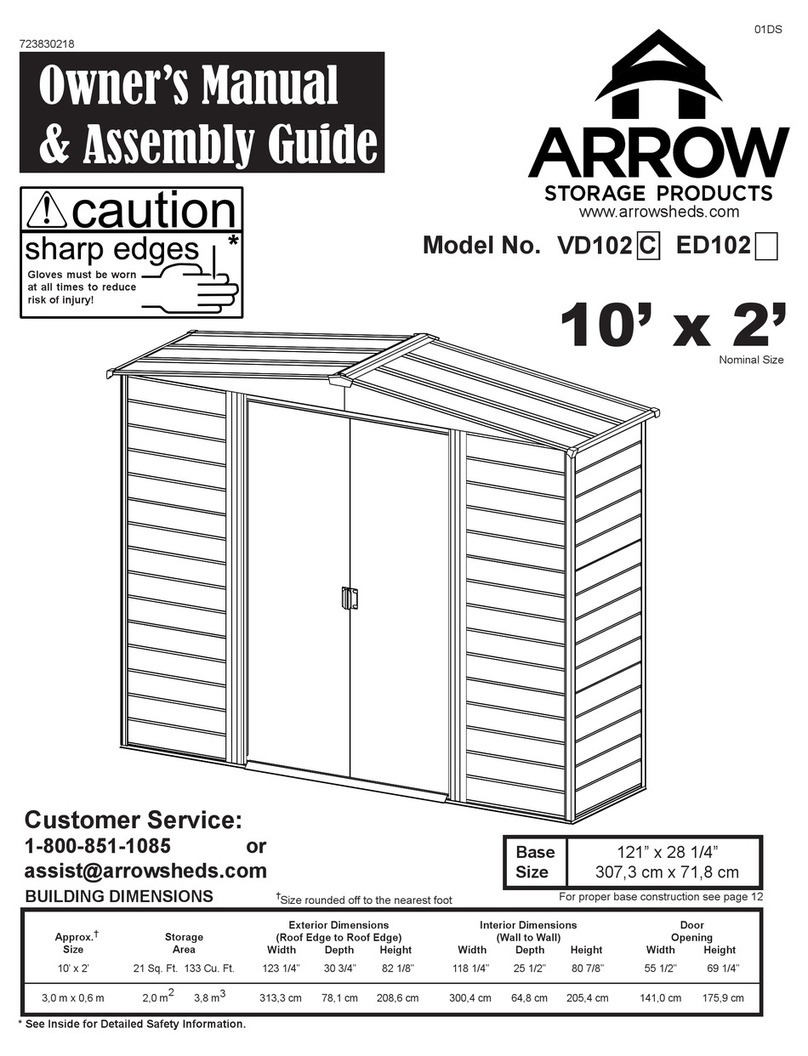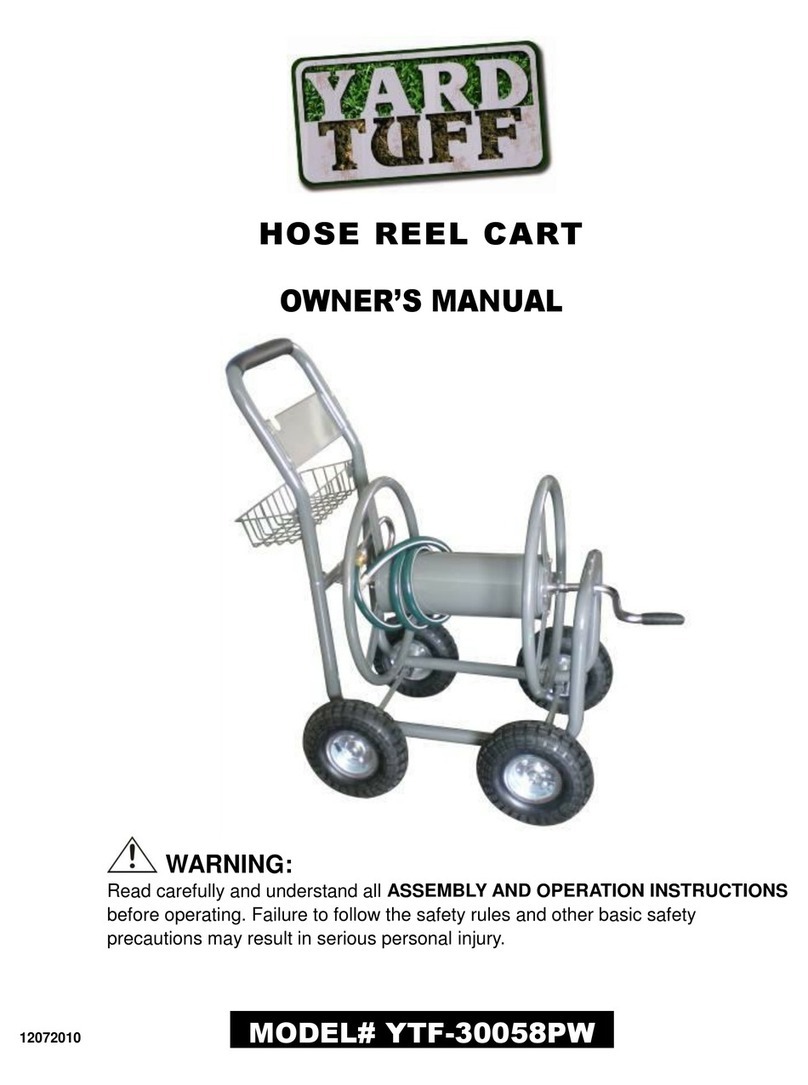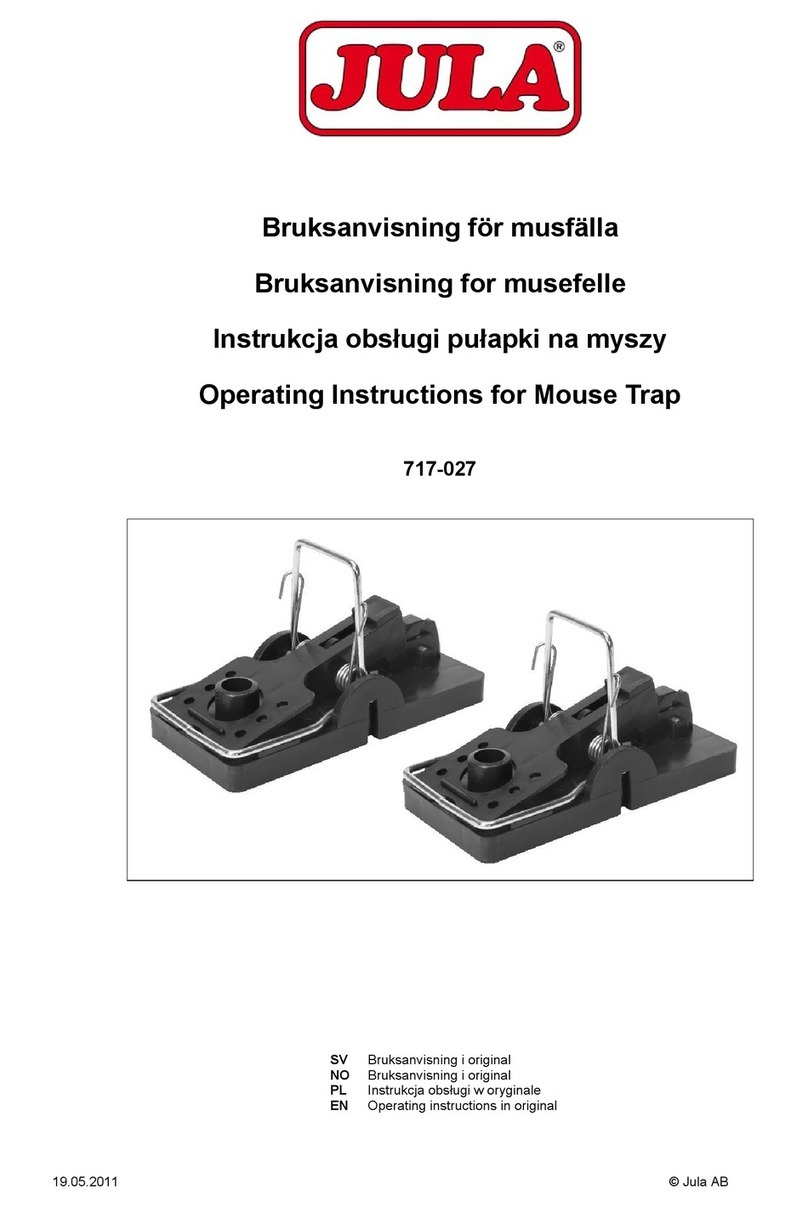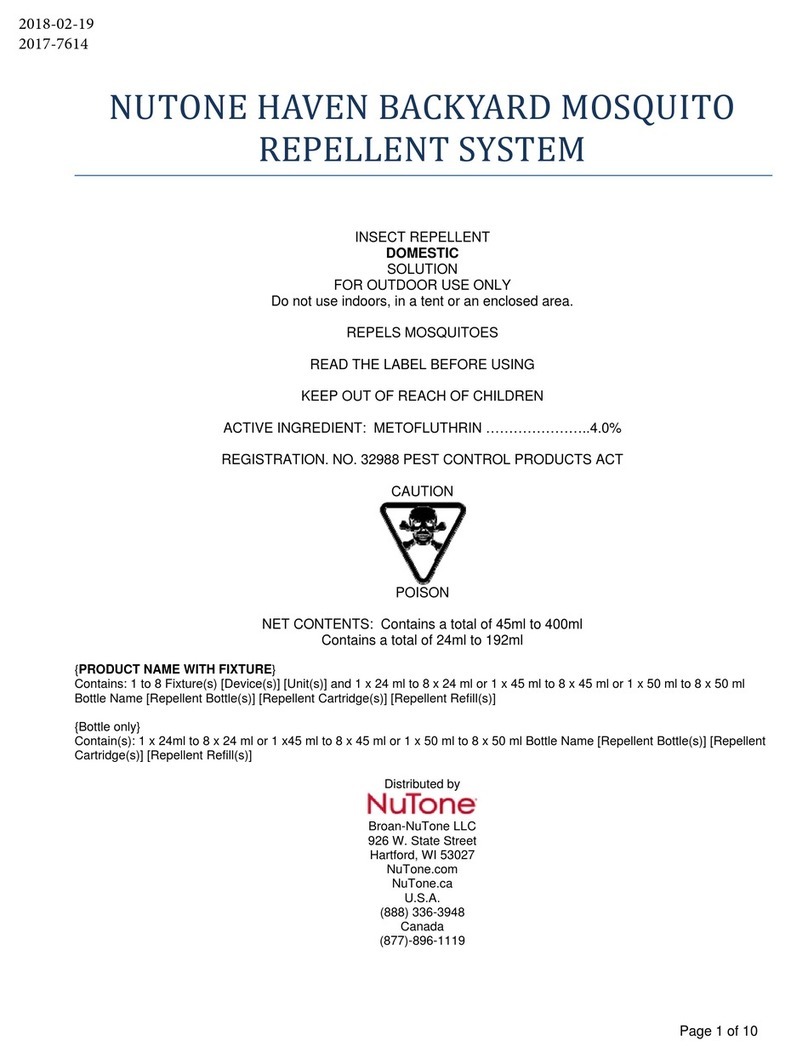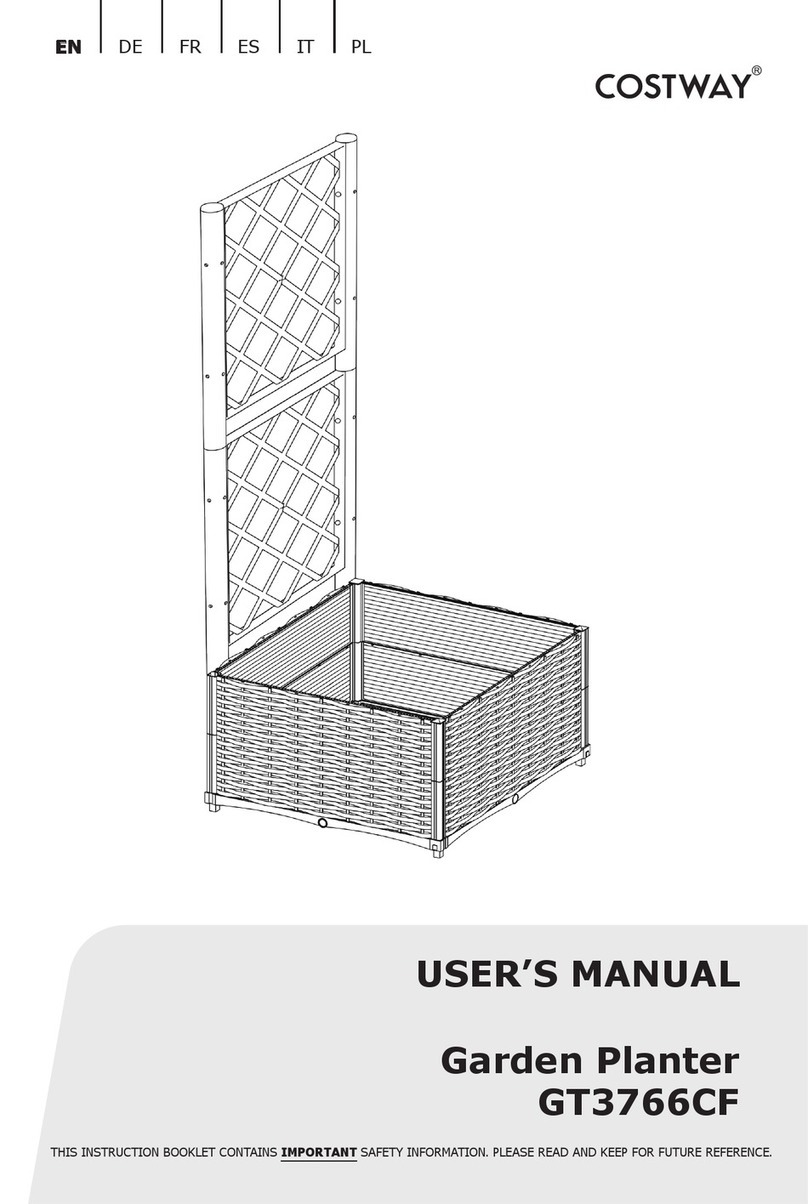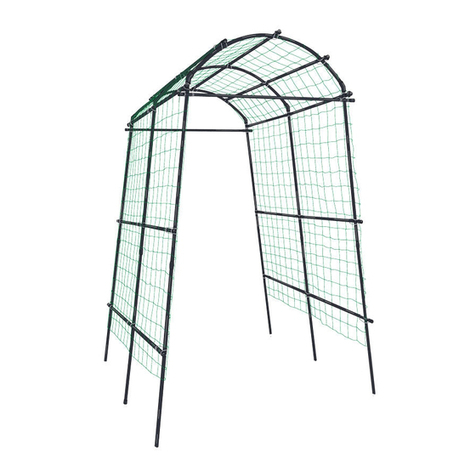Im-en Export Frijters Rijsbergen B.V LaserOP 3.0 User manual

Instruction
manual
To scare birds with a laser beam
© 2017
Im- en Export Frijters Rijsbergen B.V
Translated Instruction Manual
Version 2.1 / 2017

Summary
2
1 INTRODUCTION 3
1.1 Warranty 3
2 LASEROP 4
2.1 Intended Use in Professional Environments 4
2.2 Symbols within this Instruction Manual and on the LaserOp device 4
2.3 LaserOp case and contents 5
2.4 LaserOp device description 5
3 SAFETY 6
3.1 Safetyrequirementsforusebyatrained&qualiedoperator/user 6
3.2 Information and safety requirements for class 3b laser devices 7
3.3 Residual risks 8
4 USE AND OPERATION 9
4.1 Inserting the batteries 9
4.2 Powering up the LaserOp 9
4.3 Changing the batteries 10
4.4 UsingtheLaserOpintheeld 10
4.5 Cleaning by the user 12
4.6 Storingofthedevicebytheuser 12
4.7 Service and repairs 12
5 TECHNICAL SPECIFICATIONS 13
6 FAULTS OVERVIEW 14
7 EC-DECLARATION OF CONFORMITY 15
8 CONTACT DETAILS OF MANUFACTURER 16

Thank you very much for choosing this laser operated scarecrow from it’s manufac-
turer Im- en Export Frijters Rijsbergen B.V. On the Internet, Im- en Export Frijters
Rijsbergen B.V. uses the name www.ketrop.com
This Instruction Manual describes the LaserOp “3.0”, hereafter called “LaserOp”, and
contains the necessary instructions to operate, clean and service the device. Only this
way safe operation, proper functioning, and extended device life can be guaranteed.
This Instruction Manual has been compiled with great care. However, should you nd
any ambiguities, please contact your supplier before starting the operation of the
LaserOp.
The images in this Instruction Manual are intended as instructive material only and
cannot serve any other purpose.
Please read this Instruction Manual carefully before operating the
device. Always keep this Instruction Manual near the LaserOp as a
reference, in order to have the opportunity to consult the Operating
and Safety Instructions it contains at any time.
Operating the LaserOp is ONLY allowed if this Instruction Manual is
thoroughly known and understood!
The operator should respect all Usage Requirements and enforce these
within his company.
1.1 WARRANTY
For this point, the General Terms & Conditions of Im- en Export Frijters Rijsbergen
B.V. are applicable. Im- en Export Frijters Rijsbergen B.V. cannot be held liable for any
injuries or damages that may occur, if the LaserOp is used in any other way than those
described in the Intended Use, the Operating Instructions and the Usage Require-
ments, and/or if the LaserOp had been modi ed in any way.
© Copyright
Nothing within this edition may be copied, reproduced or stored onto a retrieval
system without the written approval of Im- en Export Frijters Rijsbergen B.V.
This is a translated copy of the original Instruction Manual, written in the Dutch
language.
Please read this Instruction Manual carefully before operating the
device. Always keep this Instruction Manual near the LaserOp as a
reference, in order to have the opportunity to consult the Operating
1 INTRODUCTION
3

2 LASEROP
2.1 INTENDED USE IN PROFESSIONAL ENVIRONMENTS
Your LaserOp has been specially designed as a professional tool, to be used by a trained,
quali ed, and speci cally designated specialist (preferably certi ed/authorised internally at
the operator’s organisation).
The LaserOp is intended to be used outdoors only.
The LaserOp is appropriate to scare birds away, from a close range up to a distance of 2 km
(~1 mile), depending on the environmental conditions. The LaserOp’s ef ciency is at its best
on darker days (e.g. during winter) or at sunrise/sunset, when the birds are most active.
The LaserOp is powered through batteries.
The LaserOp has proven to be successful in many different situations, scaring away all kinds
of nuisance causing birds. It is ef cient on farm elds, horticulture plots, cereal storing
facilities, cattle stables, country estates, land lls and industrial properties.
A frequent usage of the LaserOp will cause the birds to return less quickly after they were
scared away.
The laser is to be operated with the smallest possible beam.
2.2 SYMBOLS WITHIN THIS INSTRUCTION MANUAL AND ON THE LASEROP
SYMBOL MEANING SYMBOL MEANING
Take care!
Important instruction
within the Instruction
Manual
Reading the
Instruction Manual is
mandatory
Class 3b laser beam
Label on the LaserOp:
Laser beam window
“Never look into
the laser beam and
never point the beam
towards persons”
Label on the LaserOp:
Laser beam
“Never look into
the laser beam and
never point the beam
towards persons”
“Class 3B Laser
Device”
4

2.3 LASEROP CASE AND CONTENTS
2.4 LASEROP DEVICE DESCRIPTION
5

Before operating the LaserOp, make sure to carefully read the Safety Instructions.
3.1 SAFETY REQUIREMENTS FOR USE BY A TRAINED &
QUALIFIED OPERATOR/USER
Before powering and/or operating the LaserOp, you should hold the
LaserOp in your hand, as if it were a ashlight. The LaserOp should t com-
fortably in your hand, as to avoid the risk of uncontrolled movements.
> NEVER look into the laser beam when you are at less than 1,016 metres
(0.65 miles) from the device as this would cause serious eye damage. If you
accidentally do look into the beam, seek immediate medical attention in
order to check possible eye damage.
> NEVER point the beam towards another person.
The applicable legal requirements for the operator have to be applied and
obeyed by the operator. The operator must obey the laws and rules that
are applicable at the time of use.
> The commissioning, setup, operating, cleaning and servicing of the
LaserOp can only be performed by specially trained personnel. A guaran-
teed “internal certication/authorisation” at the operator’s organisation is
necessary in order to avoid that the LaserOp could be improperly used and
be turned into a hazard for the operator and possibly exposed persons.
By “internal certication/authorisation”, we mean certied log-keeping and
justication of all usage.
> Ensure no other people are close to the working area. Ensure that only
trained & certied/authorised personnel will be allowed to operate the
LaserOp.
> NEVER hand out a LaserOp device to any “non certied/authorised” per-
son. NEVER allow that children might touch the LaserOp device. ALWAYS
store the device in a locked enclosure.
> Using the device near residences, roads and any other obstacles is not
allowed. The operation of the device can only be allowed after a properly
executed risk assessment / risk inventory evaluation, and after all neces-
sary measures for risk reduction have been taken.
3 SAFETY
6

7
3.2 INFORMATION AND SAFETY REQUIREMENTS FOR
CLASS 3B LASER DEVICES
3.3 RESIDUAL RISKS
The laser classication and this Instruction Manual have been compiled
in accordance with the harmonized European Standard EN IEC 60825-
1:2014.
The output power of this laser device is 100 mW at a laser beam wave
length of 532 nm with a fully opened lens.
The power denition is in conformity with the European Standard EN
60825-1:2014 and amounts to 21 mW over 7 mm at a distance of 100 mm
from the lens.
The following table shows the power values for given distances, in accor-
dance with EN 60825-1:2014 (NOHD).
In the Netherlands, the operator should comply with the requirements
listed in sections 6.12, 6.26, and 6.27 of the ARBO-resolution. In Belgium,
the user should consider the public health laws.
The residual risk of the LaserOp device is that eye damage may occur after
looking straight into the laser beam, with or without optical devices.
The operator should ensure that neither himself or any
exposed persons could look straight into the laser beam, which could lead
to eye damage or even blindness.
> If necessary, place warning signs up to a distance of 1,016 metres (0.65
miles) for any possibly exposed persons, even if such persons would be
trespassing on “forbidden premises”.
> NEVER point the laser beam towards airplanes, boats, moving vehicles,
or any other object for which the light might be hazardous.

8
NEVER look into the laser beam when you are at less than 1,016 metres
(0.65 miles) from the device as this would cause serious eye damage.
If you accidentally do look into the beam, seek immediate medical
attention in order to check possible eye damage.

4 USE AND OPERATION
9
4.1 INSERTING THE BATTERIES
4.2 POWERING UP THE LASEROP
Only trained and “internally certi ed/authorised” operators are allowed to
use this device in a professional environment.
NEVER allow yourself to be distracted when you are operating the device.
Ensure the light source of the LaserOp is clean at all time.
ALWAYS remove the batteries BEFORE cleaning the lens. Ensure to NEV-
ER look straight into the light source of an active laser, as this might lead to
irreversible eye damage!
Do not operate the LaserOp if people are or could be within the reach of
the laser beam.
1. Power up the LaserOp with the ON/OFF key switch located in
the middle of the end cap.
2. Next, push the main switch, the
control light turns on.
3. As soon as the main switch is
released, the device turns off.
> The LaserOp may need to warm
up from 10 to 30 seconds before
delivering the brightest beam.
4. The adjustment knob at the front of the lens allows you to narrow
down the beam or to widen it instead.
Getting started: Ensure the batteries are fully loaded at 3.7 volts, as supplied.
1. Turn the end cap to the left and
remove it.
2. Insert or replace the batteries
with the positive (+) side pointing
outwards in the battery compartment.
3. Screw the end cap back onto the
LaserOp; the device is now ready
for use.

10
4.3 CHANGING THE BATTERIES
4.4 USING THE LASEROP IN THE FIELD
1. Turn the key switch on the end cap to the Off position.
2. Follow the instructions as indicated in section 4.1 - Inserting the
batteries.
ALWAYS point the laser beam downward when you switch ON the
LaserOp. Then slowly sweep the beam across the lot towards your
objective – the birds – in order to scare them away. Aim directly
towards the birds or just above them.
Normally, the birds will immediately ee to a nearby hiding place; follow them with
the beam to scare them away from their hiding place. If this is regularly done, the
birds will soon regard that hiding place as a “no go area” (unsafe).
If the LaserOp is regularly pointed at their roosting places at sunset and/or sunrise,
they will soon look for another roosting place.
The LaserOp is intended to be used at times when daylight is less intense at the
premises, e.g. during winter. The beam will not be seen in bright sunlight and will
therefore not be efcient.

11

4.5 CLEANING BY THE USER
4.6 STORING OF THE DEVICE BY THE USER
4.7 SERVICE AND REPAIRS
Remove all power from the LaserOp by removing the batteries en follow
the instructions in the instruction manual before cleaning the LaserOp.
Contact your supplier for more information if required.
Service and repairs should only be performed by the manufacturer:
Im- en Export Frijters Rijsbergen B.V.
Smokstraat 2, 4891 ZK Rijsbergen (NL)
The Netherlands
Phone: 0031 (0)6-51 35 34 47
E-mail: info@ketrop.com
or by the supplier of your LaserOp.
With the exception of the battery compartment, the LaserOp may never
be opened by the user.
The device should be stored in a dry and dust free area, at constant ambient
temperature.
Getting started: The LaserOp has the IP 52 protection class. The number 5 indicates
a high degree of protection against dust and the number 2 means tightness against
water droplets. NEVER clean the LaserOp with water or rinse it below the water tap.
NEVER leave the LaserOp outside. If the LaserOp gets wet, immediately sweep it dry.
> The user is allowed to clean the lens of the LaserOp.
> The lens of the device may only be cleaned with a soft, dry cloth or with special
camera lens cleaning tissues. Avoid scratches!
> The external surfaces of the device may be cleaned with a soft, dry cloth.
12

5 TECHNICAL
SPECIFICATIONS
Im- en Export Frijters Rijsbergen B.V. reserves the right to change the above men-
tioned technical data, as a result of the ongoing innovative development of the
LaserOp, without prior notication.
Furthermore, the technical data may be different from one country to another.
13

6 FAULTS OVERVIEW
14

7 EC-DECLARATION OF
CONFORMITY
EC-Declaration of Conformity
(Directive 2014/30/EU)
Im- en Export Frijters Rijsbergen B.V., Smokstraat 2, 4891 ZK Rijsbergen (NL),
The Netherlands, hereby declares that the device, hereafter called LaserOp,
meets the requirements of the Directives and Standards mentioned hereafter
amongst others.
Type: LASEROP 03 Serial number: LaserOp Year Built: 2017
Applied EC directive:
• EMC-Directive 2014/30/EU
Applied Standards:
• EN IEC 60529:1992/A1:2000 (Degrees of protection provided by
enclosures (IP Code))
• EN IEC 60825-1:2014 (Safety of laser products. Equipment
classi cation and requirements)
• EN 61000-6-2: 2005 (Electro Magnetic Compatibility (EMC) - Chapter
6-2: Generic Standards – Immunity for Industrial Environments)
• EN 61000-6-4:2006+A1:2011 (Electro Magnetic Compatibility (EMC)
– Chapter 6-4: Generic Standards – Emission Standard for Industrial
Environments)
Rijsbergen, August 20, 2017
A. Frijters, CEO
15

Im- en Export Frijters Rijsbergen B.V.
Smokstraat 2
4891 ZK Rijsbergen (NL)
The Netherlands
Phone: 0031 (0)6-51 35 34 47
E-mail: info@ketrop.com
8 CONTACT DETAILS OF
MANUFACTURER
16
Table of contents
Popular Lawn And Garden Equipment manuals by other brands
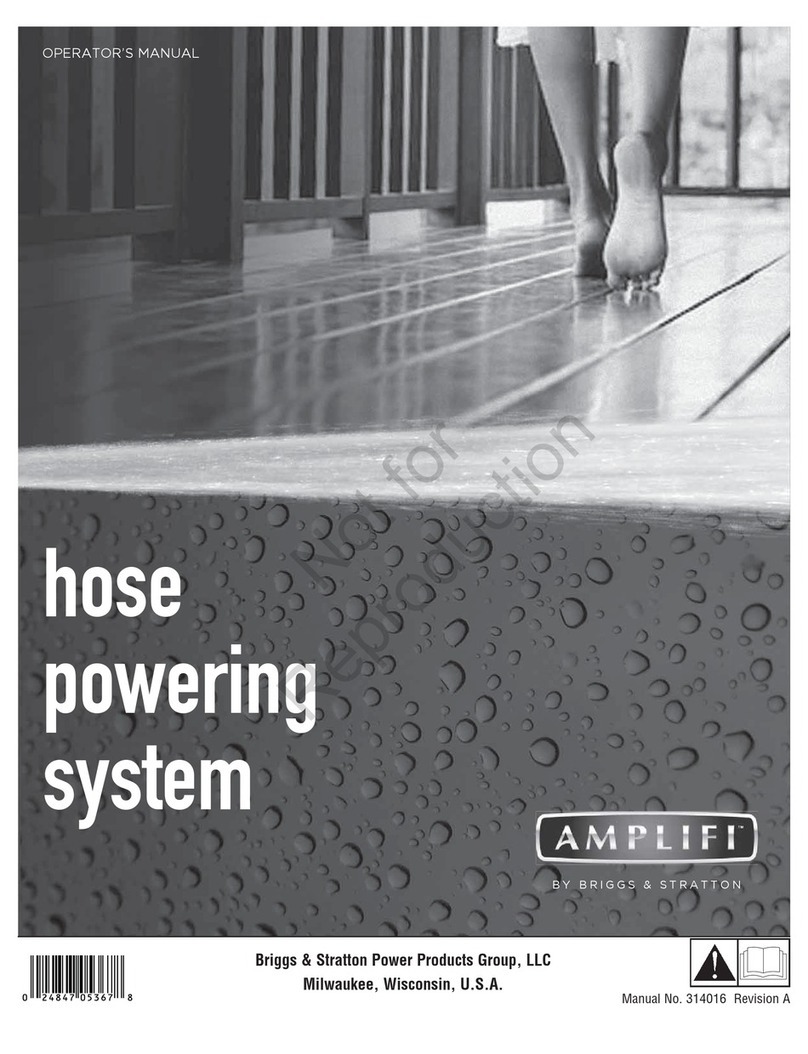
Briggs & Stratton
Briggs & Stratton Amplifi 020424 Operator's manual

Texas A/S
Texas A/S WR140 user manual
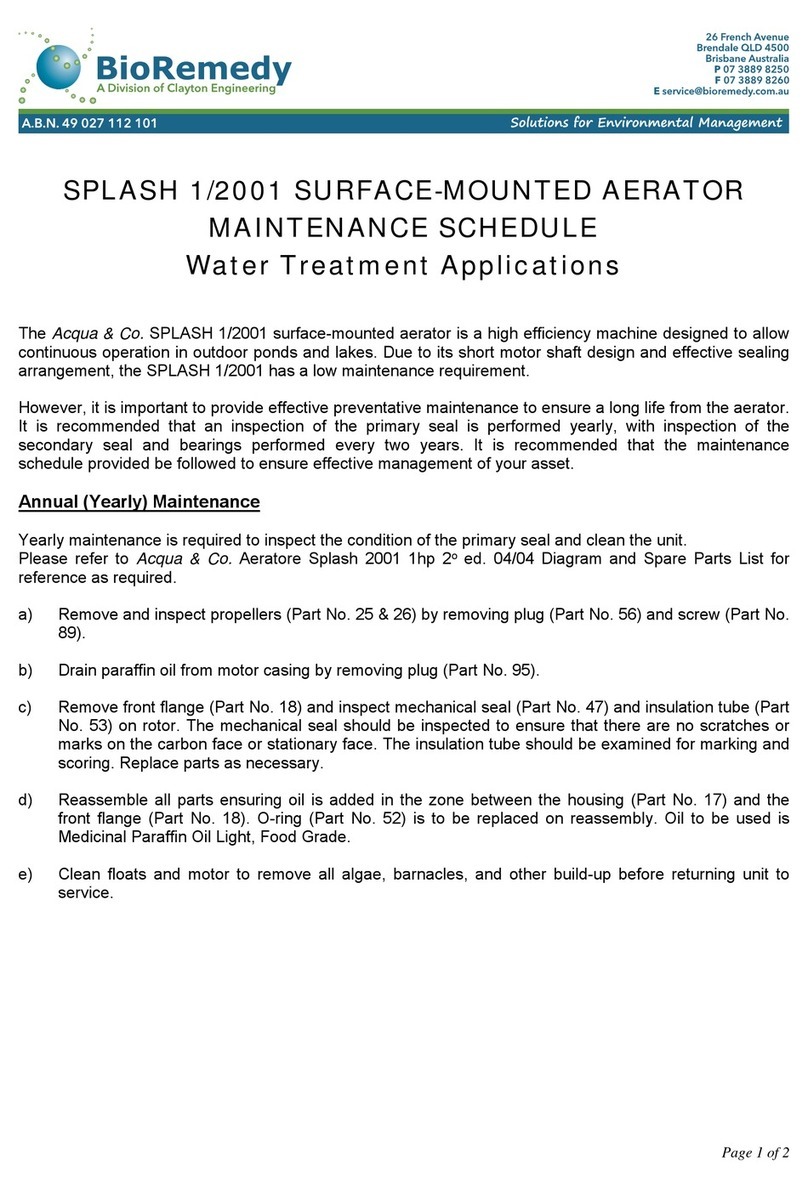
Acqua
Acqua SPLASH 1/2001 Maintenance schedule
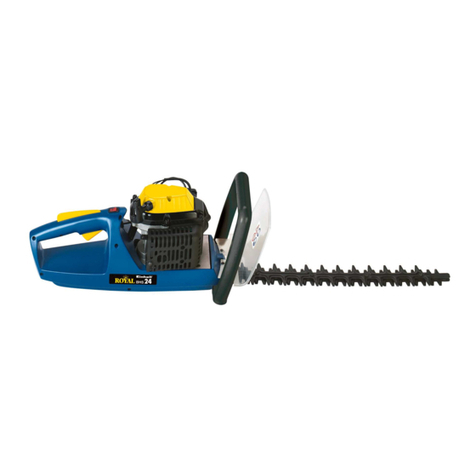
EINHELL
EINHELL Royal BHS 24 operating instructions
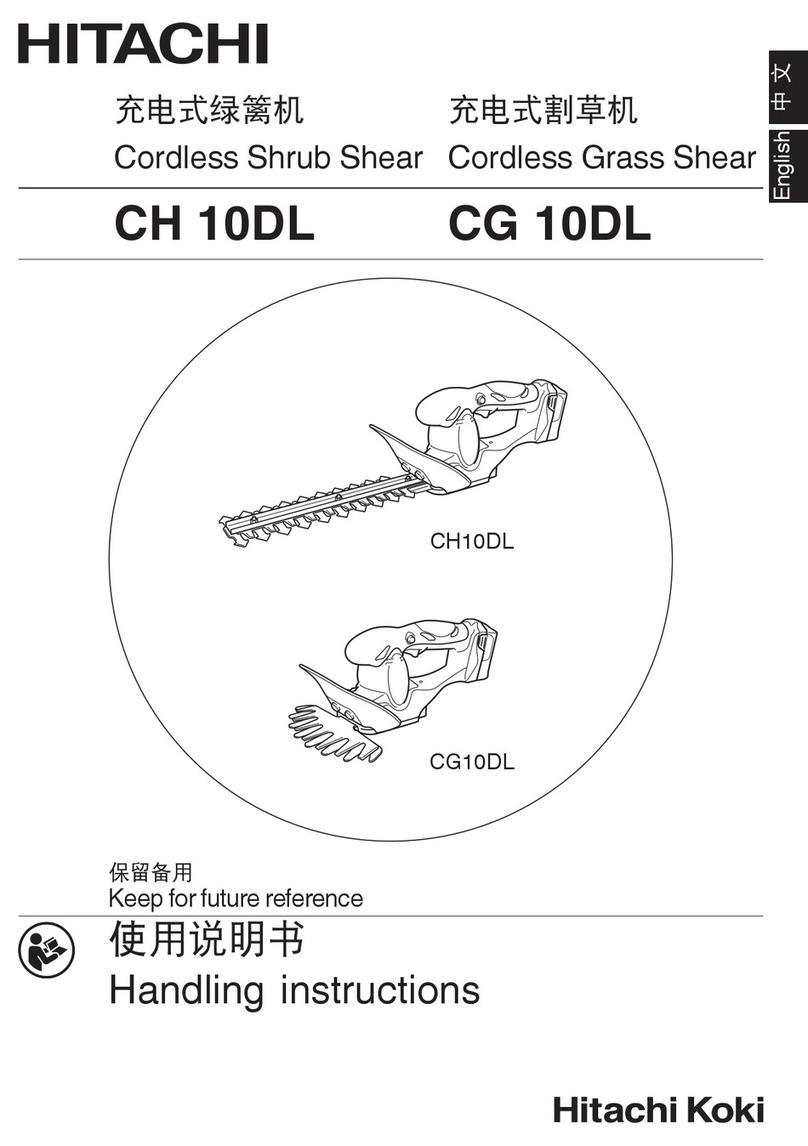
Hitachi Koki
Hitachi Koki CG 10DL Handing instructions
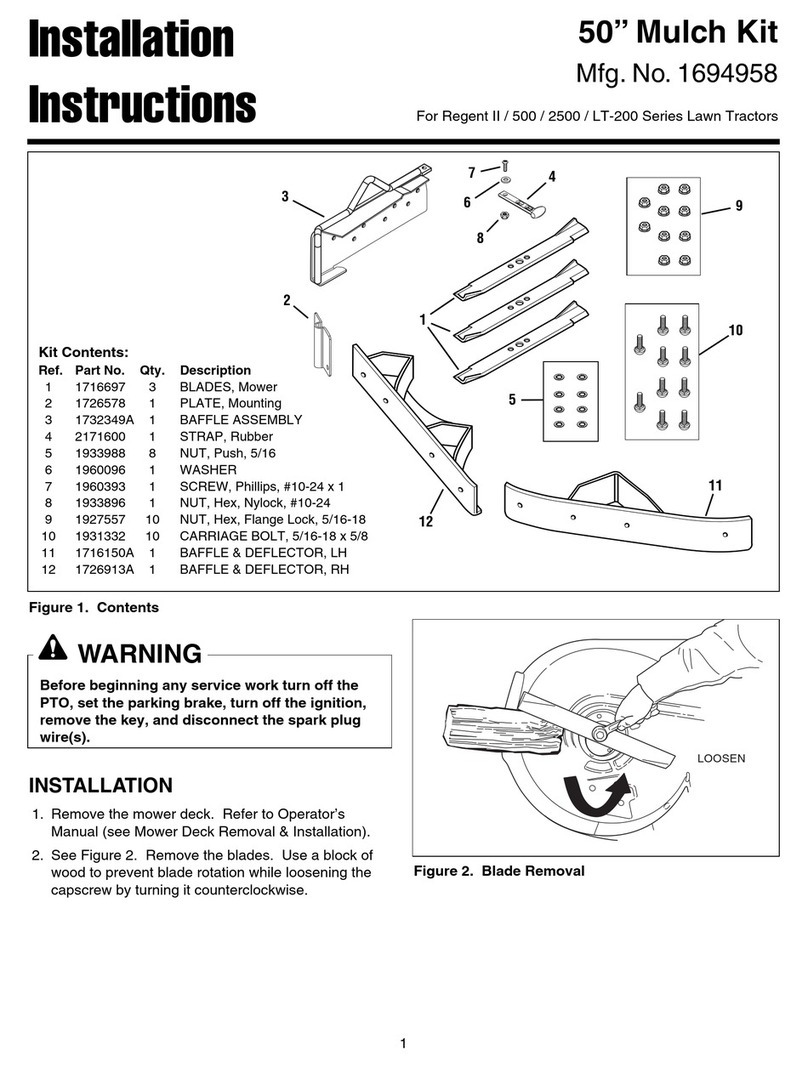
Simplicity
Simplicity 50” Mulch Kit installation instructions

